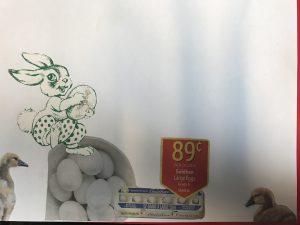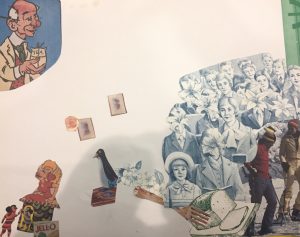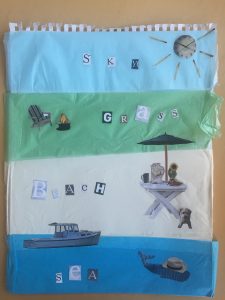I really enjoyed the activity we did on Monday. I was trying to deal with themes of body image and the narrative that American fashion places on people of all genders. I know the idea has probably been done before by collage artists, and I am sure it has been tackled by artists that work in other mediums, but it was a new area for me to tackle. I wanted to show the absurdity and specificity of the American standard for “what looks good”. I was also interested in how that is portrayed. I felt that the catalog portrayed a strong sense of male and female archetypes in order to sell the images. The men and women wore typically straight cis-gendered clothing that appealed to the typical traits of masculinity and professionalism, and femininity and style, respectively. I wanted to play around with these images to see what implications arose when I mixed and matched the traits of the different traits the models seemed to portray. So, I cut out some of the heads of the models and placed them on the bodies of different models. I also replaced some of the men’s legs with women’s legs.
I was inspired by how the catalog creators chose the images and the models they thought would appeal to a general audience. They had men’s bargain suits, blazers, and pants. They also had women’s blouses, pants, purses, and hats. These are pieces of clothing that everyone needs at some point in their life (women’s accessories and the men’s clothing are not everyday essentials, however). In other words, the catalog, based on the items it featured and the models it featured, is meant to appeal to everyone between the ages of 18 and 55. The catalog creators do not necessarily want to discriminate a certain demographic from buying their material. On the contrary, they want everyone to buy their products – they want the most business possible, after all. However, I did find it interesting that the models they showed wearing their products were mostly young or youthful-looking, attractive white men and women. This, of course, is nothing new – catalogs and magazines have always used these kinds of models because that is what looks best and that is what sells their product.
The problem for me arises when companies expect people who do not look like their models to buy their products. Again, this is nothing new and I am sure most people have recognized this by now, however it exposes a problematic presumption that companies have about the American consumer: it is that the American consumer will buy anything in a catalog that looks appealing in order to make themselves become more appealing. Why do we automatically default to young, white attractive people when considering if we should buy something to make ourselves look better? The obvious answer is that the majority of people who look at these catalogs will likely be white. But what about the people who are not white? Are they to buy the items from the catalog too? There is an unintended arrogance embedded in the composition of these catalogs that non-white consumers should buy these products even they are not considered or minimally considered. That said, there were a few black male and female models. To be clear, it’s not that having predominantly white male and female models is inherently wrong – on the contrary, it makes sense to have so many of these kinds of models. But, in an America headed by the Trump administration (and all the social implications that that title entails), and in a time when Americans seemingly or split on key societal issues, it is worthwhile to take a closer look at images we so often take for granted and deconstruct why we believe in them or why we agree with them. The same arrogance (or ignorance, or apathy) that catalog creators have when catering to its audience, is the same arrogance that Donald Trump has as he sets the tone for his presidency in a post-Obama America. In turn, this arrogance will inevitably be “bought” by those who choose to support him and so lives on the cyclical nature of arrogance. It is not that Donald Trump is necessarily a bad person, just like the catalog creators did not set out to marginalize minorities, it is that when these images and ideas are consumed by the masses, we are buying into ideologies that may end up hurting us.





